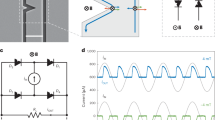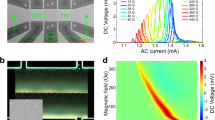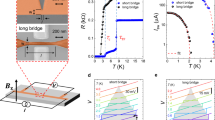Abstract
Superconducting electronics is of use in the development of energy-efficient classical and quantum computing applications. Non-reciprocal superconducting circuit elements, such as superconducting diodes, are needed for such systems, but integrating several superconducting diodes in a superconducting circuit remains a challenge. Here we report a superconducting diode bridge that consists of multiple superconducting diodes with reproducible characteristics and operating temperatures of a few Kelvin. The superconducting diodes are fabricated from thin-film bilayers of the elemental superconductor vanadium and the insulating ferromagnet europium sulfide. Four practically identical diodes are patterned on the same superconducting film to create the superconducting diode bridge. The bridge can function as a full-wave rectifier with an efficiency up to 42 ± 5%, and offers alternating current (a.c.) to direct current (d.c.) signal conversion capabilities at frequencies up to 40 kHz.
This is a preview of subscription content, access via your institution
Access options
Access Nature and 54 other Nature Portfolio journals
Get Nature+, our best-value online-access subscription
$32.99 / 30 days
cancel any time
Subscribe to this journal
Receive 12 digital issues and online access to articles
$119.00 per year
only $9.92 per issue
Buy this article
- Purchase on SpringerLink
- Instant access to full article PDF
Prices may be subject to local taxes which are calculated during checkout



Similar content being viewed by others
Data availability
The data and code associated with the analysis are available at https://doi.org/10.7910/DVN/BSAD8L (ref. 54).
References
Radebaugh, R. Cryocoolers: the state of the art and recent developments. J. Phys. Condens. Matt. 21, 164219 (2009).
Çam, E., Hungerford, Z., Schoch, N., Miranda, F. P. & de León, C. D. Y. Electricity 2024 Analysis and Forecast to 2026 (International Energy Agency, 2024).
Braginski, A. I. Superconductor electronics: status and outlook. J. Supercond. Nov. Magn. 32, 23–44 (2019).
Dixit, A. V. et al. Searching for dark matter with a superconducting qubit. Phys. Rev. Lett. 126, 141302 (2021).
Kirichenko, D., Sarwana, S. & Kirichenko, A. Zero static power dissipation biasing of RSFQ circuits. IEEE Trans. Appl. Supercond. 21, 776–779 (2011).
Mukhanov, O. A. Energy-efficient single flux quantum technology. IEEE Trans. Appl. Supercond. 21, 760–769 (2011).
Mukhanov, O. et al. Scalable quantum computing infrastructure based on superconducting electronics. In Proc. 65th IEEE International Electron Devices Meeting (IEDM) 31.2.1–31.2.4 (IEEE, 2019).
McDermott, R. et al. Quantum–classical interface based on single flux quantum digital logic. Quantum Sci. Technol. 3, 024004 (2018).
Cai, R., Žutić, I. & Han, W. Superconductor/ferromagnet heterostructures: a platform for superconducting spintronics and quantum computation. Adv. Quantum Technol. 6, 2200080 (2023).
Nadeem, M., Fuhrer, M. S. & Wang, X. The superconducting diode effect. Nat. Rev. Phys. 5, 558–577 (2023).
Tokura, Y. & Nagaosa, N. Nonreciprocal responses from non-centrosymmetric quantum materials. Nat. Commun. 9, 3740 (2018).
Ando, F. et al. Observation of superconducting diode effect. Nature 584, 373–376 (2020).
Chahid, S., Teknowijoyo, S., Mowgood, I. & Gulian, A. High-frequency diode effect in superconducting Nb3Sn microbridges. Phys. Rev. B 107, 054506 (2023).
Villegas, J. et al. A superconducting reversible rectifier that controls the motion of magnetic flux quanta. Science 302, 1188 (2003).
Suri, D. et al. Non-reciprocity of vortex-limited critical current in conventional superconducting micro-bridges. Appl. Phys. Lett. 121, 102601 (2022).
Gutfreund, A. et al. Direct observation of a superconducting vortex diode. Nat. Commun. 14, 1630 (2023).
Hou, Y. et al. Ubiquitous superconducting diode effect in superconductor thin films. Phys. Rev. Lett. 131, 027001 (2023).
Narita, H. et al. Field-free superconducting diode effect in noncentrosymmetric superconductor/ferromagnet multilayers. Nat. Nanotechnol. 17, 823–828 (2022).
Jiang, J. et al. Field-free superconducting diode in a magnetically nanostructured superconductor. Phys. Rev. Appl. 18, 034064 (2022).
Trahms, M. et al. Diode effect in Josephson junctions with a single magnetic atom. Nature 615, 628–633 (2023).
Wakatsuki, R. et al. Nonreciprocal charge transport in noncentrosymmetric superconductors. Sci. Adv. 3, e1602390 (2017).
Golod, T. & Krasnov, V. M. Demonstration of a superconducting diode-with-memory, operational at zero magnetic field with switchable nonreciprocity. Nat. Commun. 13, 3658 (2022).
Lin, J.-X. et al. Zero-field superconducting diode effect in small-twist-angle trilayer graphene. Nat. Phys. 18, 1221–1227 (2022).
Cerbu, D. et al. Vortex ratchet induced by controlled edge roughness. N. J. Phys. 15, 063022 (2013).
Vodolazov, D., Peeters, F., Grigorieva, I. & Geim, A. Nonlocal response and surface-barrier-induced rectification in hall-shaped mesoscopic superconductors. Phys. Rev. B 72, 024537 (2005).
Vodolazov, D. Y. & Peeters, F. Superconducting rectifier based on the asymmetric surface barrier effect. Phys. Rev. B 72, 172508 (2005).
Moll, P. J. & Geshkenbein, V. B. Evolution of superconducting diodes. Nat. Phys. 19, 1379–1380 (2023).
Swartz, P. & Hart, H. Jr Asymmetries of the critical surface current in type-II superconductors. Phys. Rev. 156, 412 (1967).
Edwards, H. & Newhouse, V. Superconducting film geometry with strong critical current asymmetry. J. Appl. Phys. 33, 868–874 (1962).
Yasuda, K. et al. Nonreciprocal charge transport at topological insulator/superconductor interface. Nat. Commun. 10, 2734 (2019).
Itahashi, Y. M. et al. Nonreciprocal transport in gate-induced polar superconductor SrTiO3. Sci. Adv. 6, eaay9120 (2020).
Wu, H. et al. The field-free Josephson diode in a van der Waals heterostructure. Nature 604, 653–656 (2022).
Jeon, K.-R. et al. Zero-field polarity-reversible Josephson supercurrent diodes enabled by a proximity-magnetized PT barrier. Nat. Mater. 21, 1008–1013 (2022).
Baumgartner, C. et al. Supercurrent rectification and magnetochiral effects in symmetric Josephson junctions. Nat. Nanotechnol. 17, 39–44 (2022).
Ilić, S. & Bergeret, F. S. Theory of the supercurrent diode effect in Rashba superconductors with arbitrary disorder. Phys. Rev. Lett. 128, 177001 (2022).
Kokkeler, T., Golubov, A. & Bergeret, F. Field-free anomalous junction and superconducting diode effect in spin-split superconductor/topological insulator junctions. Phys. Rev. B 106, 214504 (2022).
Yuan, N. F. & Fu, L. Supercurrent diode effect and finite-momentum superconductors. Proc. Natl Acad. Sci. USA 119, e2119548119 (2022).
Davydova, M., Prembabu, S. & Fu, L. Universal Josephson diode effect. Sci. Adv. 8, eabo0309 (2022).
Pal, B. et al. Josephson diode effect from cooper pair momentum in a topological semimetal. Nat. Phys. 18, 1228–1233 (2022).
Hope, M. K., Amundsen, M., Suri, D., Moodera, J. S. & Kamra, A. Interfacial control of vortex-limited critical current in type-ii superconductor films. Phys. Rev. B 104, 184512 (2021).
Zhao, S. F. et al. Time-reversal symmetry breaking superconductivity between twisted cuprate superconductors. Science 382, 1422–1427 (2023).
Ghosh, S. et al. High-temperature Josephson diode. Nat. Mater. 23, 612–618 (2024).
Bozkurt, A. M., Brookman, J., Fatemi, V. & Akhmerov, A. R. Double-Fourier engineering of Josephson energy-phase relationships applied to diodes. SciPost Phys. 15, 204 (2023).
Cayao, J., Nagaosa, N. & Tanaka, Y. Enhancing the Josephson diode effect with Majorana bound states. Phys. Rev. B 109, L081405 (2024).
Yerin, Y., Drechsler, S.-L., Varlamov, A., Cuoco, M. & Giazotto, F. Supercurrent rectification with time-reversal symmetry broken multiband superconductors. Phys. Rev. B 110, 054501 (2024).
Pal, S. & Benjamin, C. Quantized Josephson phase battery. Europhys. Lett. 126, 57002 (2019).
Margineda, D. et al. Sign reversal diode effect in superconducting Dayem nanobridges. Commun. Phys. 6, 343 (2023).
Margineda, D. et al. Back-action supercurrent diodes. Commun. Phys. 8, 16 (2025).
Costa, A., Fabian, J. & Kochan, D. Microscopic study of the Josephson supercurrent diode effect in Josephson junctions based on two-dimensional electron gas. Phys. Rev. B 108, 054522 (2023).
Scharf, B., Kochan, D. & Matos-Abiague, A. Superconducting diode effect in quantum spin Hall insulator based Josephson junctions. Phys. Rev. B 110, 134511 (2024).
Horowitz, P., Hill, W. & Robinson, I. The Art of Electronics Vol. 2 (Cambridge Univ. Press, 1989).
Chapman, B. J. et al. Widely tunable on-chip microwave circulator for superconducting quantum circuits. Phys. Rev. X 7, 041043 (2017).
Castellani, M. et al. A superconducting full-wave bridge rectifier. Nat. Electron https://doi.org/10.1038/s41928-025-01376-4 (2025).
Ingla-Aynés, J. et al. Data underlying the publication highly efficient superconducting diodes and rectifiers for quantum circuitry. Harvard Dataverse https://doi.org/10.7910/DVN/BSAD8L (2025).
Acknowledgements
We acknowledge M. B. Ketchen, A. Kirichenko and A. Gupta for insightful discussions and M. Mondol for technical assistance. This work was supported by Air Force Office of Sponsored Research (grant no. FA9550-23-1-0004 DEF), Office of Naval Research (grant no. N00014-20-1-2306), National Science Foundation (grant nos. NSF-DMR 2218550 and 1231319) and Army Research Office (grant nos. W911NF-20-2-0061, DURIP W911NF-20-1-0074). E.-D.C. and P.W. acknowledge the NSF grant no. CAREER DMR-2046648. This work was carried out in part through the use of MIT.nano’s facilities.
Author information
Authors and Affiliations
Contributions
J.I.-A., Y.H. and J.S.M. conceived and designed the study with input from O.A.M. Y.H. grew the V/EuS films. E.-D.C. and P.W. grew the Nb/Au films. J.I.-A. fabricated the devices and performed the measurements. Y.H. and S.W. assisted with the measurements. All authors contributed to the paper.
Corresponding authors
Ethics declarations
Competing interests
The authors declare no competing interests.
Peer review
Peer review information
Nature Electronics thanks Denis Kochan, Muhammad Nadeem and the other, anonymous, reviewer(s) for their contribution to the peer review of this work.
Additional information
Publisher’s note Springer Nature remains neutral with regard to jurisdictional claims in published maps and institutional affiliations.
Supplementary information
Supplementary Information
Supplementary Sections 1–5 and Figs. 1–11.
Rights and permissions
Springer Nature or its licensor (e.g. a society or other partner) holds exclusive rights to this article under a publishing agreement with the author(s) or other rightsholder(s); author self-archiving of the accepted manuscript version of this article is solely governed by the terms of such publishing agreement and applicable law.
About this article
Cite this article
Ingla-Aynés, J., Hou, Y., Wang, S. et al. Efficient superconducting diodes and rectifiers for quantum circuitry. Nat Electron 8, 411–416 (2025). https://doi.org/10.1038/s41928-025-01375-5
Received:
Accepted:
Published:
Issue date:
DOI: https://doi.org/10.1038/s41928-025-01375-5
This article is cited by
-
Supercurrent diode effect in Josephson interferometers with multiband superconductors
Communications Physics (2025)
-
Low-loss electronics with superconducting diodes
Nature Electronics (2025)
-
A superconducting full-wave bridge rectifier
Nature Electronics (2025)



